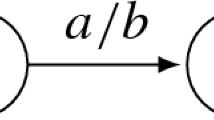Abstract
If an automatonA = (X, I, M) is strongly connected,\(\bar I\) is its characteristic semigroup ande is a minimal idempotent of\(\bar I\), then the automorphism groupG(A) ofA is a homomorphic image of a subgroup of the group e\(\bar I\)e (Theorem 3.1) and Theorem 3.3 about the necessary and sufficient conditions ofG(A) to be isomorphic to e\(\bar I\)e Theorems 3.1 and 3.2 make the result by Fleck (1965) more precise. Our method seems completely different from his method. That is, we use the result on regular permutation groups in Burnside's theory of groups of finite order (Theorem 2.1) as new results on the well-known partial ordering of the set of idempotents of a semigroup (Theorems 2.3, 2.5).
Similar content being viewed by others
References
B. Barnes, Groups of automorphisms and sets of equivalence classes of input for automata,J. Assoc. Comput. Mach. 12 (1965), 561–565.
B. Barnes, On the group of automorphisms of strongly connected automata,Math. Systems Theory 4 (1970), 289–294.
Z. Bavel, Structure and transition preserving functions of finite automata,J. Assoc. Comput. Mach. 15 (1968), 135–158.
A. C. Fleck, Isomorphism groups of automata,J. Assoc. Comput. Mach. 9 (1962), 469–476.
A. C. Fleck, On the automorphism group of an automaton,J. Assoc. Comput. Mach. 12 (1965), 566–569.
R. H. Oehmke, On the structure of an automaton and its input semigroup,J. Assoc. Comput. Mach. 10 (1963), 521–525.
G. P. Weeg, The structure of an automaton and its operation preserving transformation group,J. Assoc. Comput. Mach. 9 (1962), 345–349.
W. Burnside,Theory of Groups of Finite Order, 2nd ed., Cambridge Univ. Press, London; reprinted 1958, Chelsea, New York.
A. H. Clifford andG. B. Preston,The Algebraic Theory of Semi-Groups, Math. Surveys No. 7, Amer. Math. Soc., Providence, R.I., 1961.
A. Ginzburg,Algebraic Theory of Automata, Academic Press, New York, 1968.
H. Wielandt,Finite permutation groups, Academic Press, New York, 1964.
H. Zassenhaus,The Theory of Groups, 2nd ed., Chelsea, New York, 1949.
Author information
Authors and Affiliations
Rights and permissions
About this article
Cite this article
Uemura, K. Semigroups and automorphism groups of strongly connected automata. Math. Systems Theory 8, 8–14 (1974). https://doi.org/10.1007/BF01761703
Received:
Revised:
Issue Date:
DOI: https://doi.org/10.1007/BF01761703




